Introduction to Unified Critical Communications
Introduction to Unified Critical Communications | Tait Radio Academy
Introduction to Unified Critical Communications
Everyone is talking about unified critical communications, but how can it help your organization enhance safety and improve efficiency?
Why is everyone talking about Unified Critical Communications?
Communications have never been more important than they are today. Businesses, public safety, utilities, and other enterprises rely on communications being available all the time.
Historically, this simply meant having a reliable Radio Network. People could communicate with voice, and that was enough.
But not anymore.
Today, organizations are exploring and using LTE, WiFi, bluetooth, and many other data paths to connect their people for safer, more efficient workforces. But how can these different bearers work together? Will this make communications simpler or more complicated? How does Unified Communications actually help my organization?
These and many other questions will be answered in Introduction to Unified Critical Communications.
Course syllabus
Lesson 1: What is Unified Critical Communications?
Odds are, you’ve heard the term Unified Critical Communications. In this lesson, you’ll watch four videos that explore how it’s revolutionizing communications and the advantages it brings.
Lesson 2: How to Choose the Right Communication Bearers
Trying to decide which forms of communication are right for your organization? In this lesson, we look at the pros and cons of LMR, WiFi, Satellite, and LTE.
Lesson 3: What is the Future of LTE?
The LTE standards suite continues to evolve and improve the technology. LTE already offers a lot of great benefits to users, but what does the future hold for mission critical organizations?
Lesson 4: The Benefits of Unified Critical Communications
In this lesson, we explore the generic benefits of Unified Critical Communications and then apply those benefits to specific industries who rely on critical communications.
Lesson 5: Final Assessment - UCC
Finished taking the Unified Critical Communications course? Test your knowledge with this quiz, available to registered user. Pass the quiz and you’ll receive an official certificate!
What is Unified Critical Communications?
Odds are, you’ve heard the term Unified Critical Communications. In this lesson, you’ll watch four videos that explore how it’s revolutionizing communications and the advantages it brings.
- Revolution in Critical Communications explains how Unified Critical Communications are changing the game.
- Driving the Revolution explores the reason the critical communications market has changed so much over the last decade and why change will continue into the future.
- What Makes Critical Communications ‘critical’? takes a look at the requirements for critical communications that keep our most important organizations working.
- Advantages and Issues of multiple bearers and devices identifies the different benefits and challenges that come with a unified critical communications network.
What is Unified Critical Communications?
THE REVOLUTION IN CRITICAL COMMUNICATIONS
Why is everyone talking about unified critical communications?
Communications have never been more important than they are today. Businesses, public safety, utilities, and other enterprises rely on communications being available all the time.
For years, critical communications have been defined by the major land mobile radio digital technologies including TETRA, P25, and DMR.
The parameters for mission critical voice and data services have been framed by what land mobile radio could deliver. But now, some are saying that LTE (or Long Term Evolution) and eventually 5G will better meet all the core requirements of public safety, utilities, transport, mining and other critical communications users.
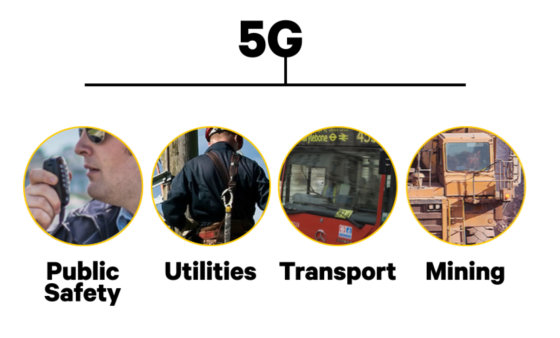
These technologies won’t replace their predecessors overnight, but the transition to embrace broadband data has already begun, and users should start planning now for this future.
However, there is a new model for critical communications called unified critical communications.
Unlike traditional critical communication solutions, unified critical communications replaces traditional single technology solutions with communications over multiple bearers.
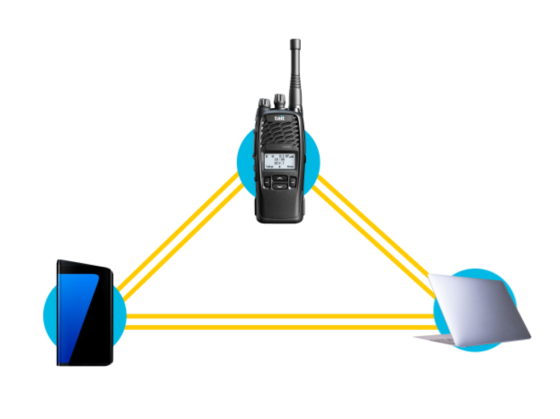
Unified critical communications combine the strengths of different technologies while mitigating their weaknesses. It also integrates different networks so that they are managed as one. This enables organizations and agencies to deliver critical communications to their personnel as a service.
In this course, we will look at some of the technologies and issues that have triggered this communications revolution. Our goal is to provide you with a foundation to begin planning for your own organization’s critical communication future.
Let’s get started!
WHAT IS DRIVING THE REVOLUTION?
AT&T estimates that there are roughly ten million LMR radios worldwide, of which 40% can be classified as ‘critical’ communications users. While LMR still dominates the market, people are also using mobile phones, tablets, smart devices, and cameras to stream video, automate asset tracking, perform mapping, run real time data analytics, monitor health status and other advanced functions that are well beyond LMR.
The difference is data. New technologies such as LTE can deliver lots of data – fast – something LMR cannot do. And more data means more capabilities. Just consider the difference between what you can do on a two-way radio and what you can do on a cellular phone. There is a smartphone application, often with a slick user interface, to cater for almost any need. Businesses can readily develop their own applications to meet customized requirements. In contrast, LMR applications are few and far between.

A second driver for change is connectivity. The ability to connect devices to each other and to networks using Wi-Fi or open standard IP protocols means that business solutions can be designed around multiple devices (e.g. tablet, cell phone, radio) rather than being held hostage to a single type of device (e.g. radio).
Open standards for connectivity have led to the development of a wide variety of specialized devices aimed at professional users. It is not uncommon to see a policeman with a P25 radio, Bluetooth microphone, tablet, cellphone, and wearable camera (with maybe more comms equipment such as an MDT in the car).
In principle, all of these could be connected into a common system, but typically the agency will support the radio and cellphone (for example) on separate systems.

The question is, “Is this too much?”
Some have argued that this profusion of comms equipment is over-complicated, too expensive, and completely unnecessary. In particular, LTE technology can carry nearly all of the services – voice and data – required by professional users. Additional communications bearers, such as LMR, should probably be retired. A few commentators have even suggested that LMR users would be better off renting capacity on commercial LTE networks rather than maintaining their own radio systems.
And this is already happening. Small businesses, hotel chains, casinos, construction and trucking companies have ditched their LMR in favor of LTE smartphones. But organizations who have made this move tend to be noncritical communications users.
So what makes critical communications ‘critical’? And what are the advantages of using multiple communications bearers and multiple devices? We’ll find out in the next topic.
WHAT MAKES CRITICAL COMMUNICATIONS, ‘CRITICAL’?
Communications are ‘critical’ when they are essential to the operation of an organization. Failure or disruption of communications either seriously impacts or halts an organization’s activities.
There are several senses of ‘critical’ that may be involved:
- Business critical – where comms failures severely disrupt business activity and may result in significant penalties. For example, power utilities face major financial penalties if comms failures during maintenance lead to downtime exceeding allowable targets.
- Mission-critical – where comms failures stop or greatly degrade a mission activity. For example, an emergency response during a disaster.
- Safety critical – where comms failures lead to property damage, injury, or loss of life. For example, communications failures during a SWAT team response.
- Security critical – where comms failures lead to the loss or damage of sensitive data or a compromise of system integrity. For example, in banking systems.

Depending on your organization and what it does your communications may be critical in any or all these senses. For instance, during a hurricane response, communications for a Utility are critical to the business, mission, safety, and security of their operations and their customers.
So what general features would we expect a critical communications system to have?
- 24/7 Coverage in all critical areas including in-building coverage.
- Fast, reliable connection including failsafe communications that kick in when all other systems collapse or when key parts of the communications network are damaged. This may involve some form of direct mode communications which do not require access to a network, such as simplex radio. Also, dependable mobile connections with fast, smooth handovers across the network.
- Good group communications for both voice and data. Talkgroups may need to be set up and modified on the fly and should allow individuals to enter a group call after it has started (also known as ‘late entry’).
- Ability to prioritize calls, talkgroups. and key personnel. Thus, emergency calls, key command or management groups, and personnel should be able get priority access and even pre-empt calls in progress.
- Security to encrypt communications, protect data integrity, and authenticate users, applications, and server equipment.
Depending on your organization’s needs, there may be other, more specific requirements for your critical communications system.
Next up, we’ll discuss the advantages and issues of multiple bearers and devices.
WHAT MAKES CRITICAL COMMUNICATIONS, ‘CRITICAL’?
Communications are ‘critical’ when they are essential to the operation of an organization. Failure or disruption of communications either seriously impacts or halts an organization’s activities.
There are several senses of ‘critical’ that may be involved:
- Business critical – where comms failures severely disrupt business activity and may result in significant penalties. For example, power utilities face major financial penalties if comms failures during maintenance lead to downtime exceeding allowable targets.
- Mission-critical – where comms failures stop or greatly degrade a mission activity. For example, an emergency response during a disaster.
- Safety critical – where comms failures lead to property damage, injury, or loss of life. For example, communications failures during a SWAT team response.
- Security critical – where comms failures lead to the loss or damage of sensitive data or a compromise of system integrity. For example, in banking systems.

Depending on your organization and what it does your communications may be critical in any or all these senses. For instance, during a hurricane response, communications for a Utility are critical to the business, mission, safety, and security of their operations and their customers.
So what general features would we expect a critical communications system to have?
- 24/7 Coverage in all critical areas including in-building coverage.
- Fast, reliable connection including failsafe communications that kick in when all other systems collapse or when key parts of the communications network are damaged. This may involve some form of direct mode communications which do not require access to a network, such as simplex radio. Also, dependable mobile connections with fast, smooth handovers across the network.
- Good group communications for both voice and data. Talkgroups may need to be set up and modified on the fly and should allow individuals to enter a group call after it has started (also known as ‘late entry’).
- Ability to prioritize calls, talkgroups. and key personnel. Thus, emergency calls, key command or management groups, and personnel should be able get priority access and even pre-empt calls in progress.
- Security to encrypt communications, protect data integrity, and authenticate users, applications, and server equipment.
Depending on your organization’s needs, there may be other, more specific requirements for your critical communications system.
Next up, we’ll discuss the advantages and issues of multiple bearers and devices.
PROS AND CONS OF MULTIPLE BEARERS AND DEVICES
Now that we understand critical communications more clearly, we can better appreciate some of the advantages and issues surrounding the use of multiple bearers and multiple devices.
At first glance, running multiple bearers may seem inefficient. Why not have just radio or just cellular to carry communications services?
The short answer is that each bearer has some advantages and some disadvantages. Each differs in functionality, range, reliability, availability, equipment options, power consumption, cost and security. With multiple bearers at hand, an organization can tailor its communications deployment to meet the business requirements of each part of its operations.
For instance, no single technology can provide communication across the varied terrain, fluctuating demand, and escalating data usage that system designers must consider. Coverage holes inevitably appear, which can be mitigated if multiple bearers with different coverage characteristics are employed.
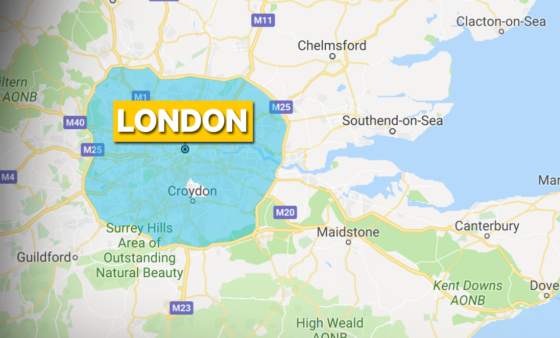
Reliance on a single technology also creates risk. Disasters and national emergencies often result the overloading of public cellular networks and jam communications. Adding multiple bearers provides redundancy to critical communications. For example, the 2005 London underground bombings overloaded the cell phone systems, but LMR radio in the buses provided alternative communications channels for London Transport. For critical infrastructure, such as a power utility, regulators may require a separate auxiliary communications network to back up the primary system in case of failure.
And sometimes it just makes sense to add a bearer to gain new capabilities. However good LMR was at providing voice communications, other bearers were needed to access broadband data services.
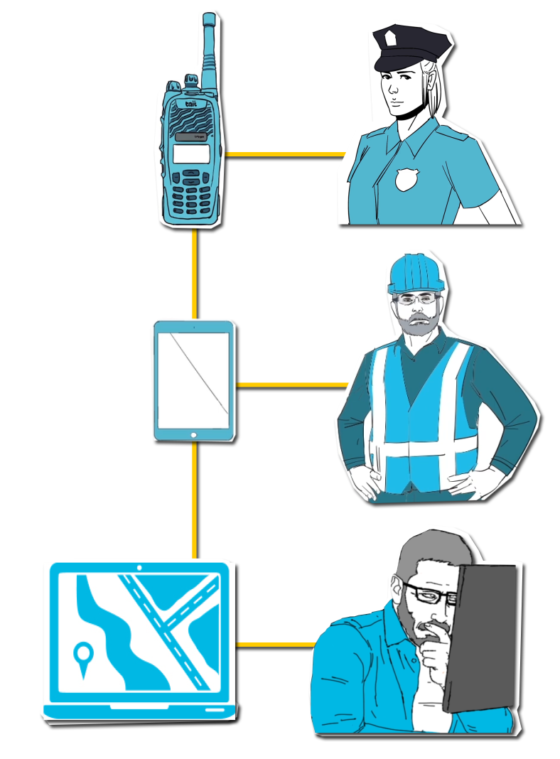
A single-bearer communications system also restricts the choice of devices for your staff. There are relatively few organizations running critical communications networks that can get by with only one or two types of comms terminal. Some sections of an organization may need big displays and robust keyboards, while other departments are happy with cellphone displays and touchscreen input. Field handhelds are usually ruggedized, often intrinsically safe, and may sport noise-cancelling microphone headsets while office comms sets can dispense with these features.
It makes commercial and operational sense to let the diverse work requirements drive the choice of bearers and devices rather than force a solution based upon what can be achieved and is available within a single technology.
Smarter communications solutions can be conceived through the integration and management of multiple technologies and the devices they support.
In real life, however, integrations of multiple bearers usually don’t go far enough. Critics of such hybrid systems say – with some justice – that these are not really coherent systems. Instead what we have is a collection of communications subsystems that appear internally integrated but are in fact managed separately and are only loosely connected.
Getting them to work together is both complex and costly. How do you coordinate overall performance or monitor security or administer consistent access control? There is a fundamental issue here about system integration and management – this issue is addressed by Unified Critical Communications.
How to Choose the Right Communication Bearers
Trying to decide which forms of wireless communication are right for your organization? In this lesson, we look at the pros and cons of LMR, WiFi, Satellite, and LTE.
In this lesson there are six different topics/videos. You can view each of them below, and we recommend starting with the first.
FACTORS TO CONSIDER WHEN CHOOSING THE RIGHT BEARERS
Maybe you’re convinced that no single device will meet all the needs of your organization, and now you’re looking at integrating multiple devices into your comms system. So, which network bearers should you consider?
Or maybe you are already using multiple technologies but want to know whether you’ve made the right choices.
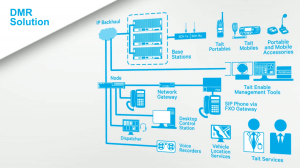
Or maybe you are looking at adding another bearer to the mix you already have.
Over the next few videos, we’ll take a look at a few pros and cons of some of the most widely deployed bearers. Factors we will consider include: coverage, reliability, service quality (whether for voice or data), and security.
PROS AND CONS OF LAND MOBILE RADIO (LMR)
For decades, land mobile radio (aka two-way radio), which operates in licensed frequencies, has been the mainstay of mobile critical communications. Used by millions worldwide in countless different conditions, constantly tested and refined, it has been the yardstick of success for critical communications, particularly in Public Safety.
From the start, LMR was geared towards voice communications. As a result, it has all the voice services that critical communications users expect including individual, group, and broadcast calls, emergency calls, various types of call prioritization, call pre-emption, simplex and so forth.

To make a call, a user presses a push to talk (PTT) button, speaks, and then releases the button to put the radio into receive mode. This type of operation is considered essential for critical communications. In dangerous or high-pressure situations, you don’t have time to look down at your phone, unlock it, find the right app, look up the right contact, and then make the call. You want to be connected as quickly and simply as possible.
LMR equipment has some of the best coverage of any wireless communications technology, with very large cell sizes, measured in tens of miles or kilometers. This coverage can be extended using a network of tall, high-power towers so that radio systems can be created to cover cities, states, and even whole nations.
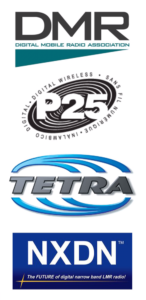
However, that excellent coverage also has a cost: high-power mobile radios need lots of power and consequently are fitted with big batteries. That is why 5W police portables with an 11 hour 5/5/90 duty cycle look as big as they do. It takes more battery power to go broadcast far distances for longer periods of time.
Modern LMR technologies such as DMR, P25, TETRA, and NXDN are all open standard and, being digital, can operate over standard IP networks. It also enables LMR to carry a certain amount of data in addition to voice.
LMR communications have an outstanding reputation for reliability based on the ruggedness of LMR equipment and on the numerous failsafe options built into LMR radios and networks.
And through its close association with public safety, security options have been developed for LMR systems, including military grade encryption of all voice and data transmissions.
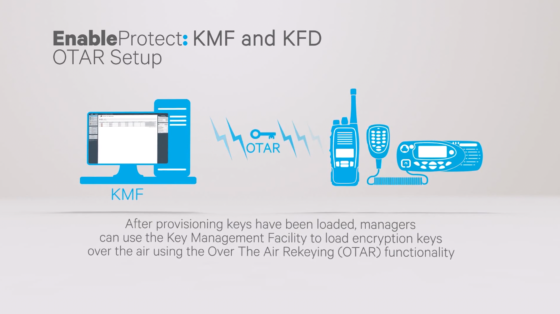
On the downside LMR is an inefficient user of scarce radio spectrum, so professional organizations sometimes struggle to find available frequencies. One consequence is that spectrum authorities have reduced LMR bandwidth in order to squeeze more users into limited spectrum. As a result, data transmission has suffered.
LMR can only offer low capacity data in its limited bandwidth, which is okay for short text-oriented data services but rules out high bandwidth data applications such as streaming video. It comes as no surprise, then, that LMR users have looked for another bearer to access broadband data.
For more on LMR, make sure you check out our Basic Radio Awareness course.
PROS AND CONS OF WIFI
Originally designed to connect office computers into local area networks (or LANs), Wi-Fi has become the go-to technology for short to medium-range wireless data communication and connection to the Internet.
A WiFi network is inexpensive, easy to install, expandable, offers low latency (better than LMR), and excellent data rates. A wide variety of devices can be made WiFi capable to connect to each other or to the Internet. Many devices such as smartphones have WiFi already installed as standard. To improve their data capability, LMR radios have started to appear with WiFi built-in. Laptops, mobile phones, radios and other devices can use WiFi to connect to business networks and applications.
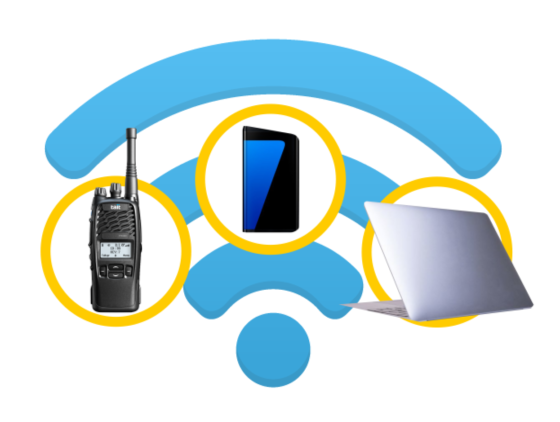
WiFi hotspots can be added to machinery for off-loading performance data captured during operation. The ability of WiFi to form ad hoc connections means that temporary networks of devices can be created on the fly.
But while WiFi data rates may be impressive, its range is not. A typical configuration might reach no further than 50 m indoors or 92 m outdoors. Extenders, increased transceiver power, and directional antennas can help, but greater range comes at the expense of the data rate. While WiFi can complement LMR to support high volume data transactions, a single WiFi node operates over a fairly short range.
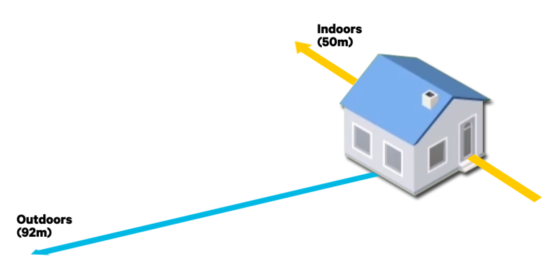
To get WiFi data coverage that matches LMR voice coverage networks of interconnected WiFi nodes – called mesh networks – are sometimes deployed. Meshed WiFi works well up to a certain network size, beyond which network overheads start to impact the data rates. To mitigate these impacts, the network may need substantial redesign (for example, by reducing the number of node inter-connections), which can compromise its resilience and may be both impractical and prohibitively expensive.
Moreover, WiFi is prone to interference, which can ruin its data rate. Bluetooth devices, remote vehicle starters, cordless phones and security cameras share the same radio frequencies as WiFi, all can cause interference. Moving machinery, which gets in the way of signals, or shifting a mobile WiFi hotspot to a blind spot can sabotage the data rate and undercut the reliability of WiFi communications.
Security is an issue for any wireless technology. Until recently WiFi has been more open to hacking then other technologies. In part, this is due to the popularity of WiFi for creating home area networks and public hotspots without turning on any security options or following good security practices.
Yet even with proper set-up and security hygiene, WiFi’s own security features have proved to be vulnerable. For example, its encryption protocols have been successfully hacked on numerous occasions, a situation which the WiFi Alliance (who look after the technology) hopes will be corrected when the latest version called WAP3 is released.
PROS AND CONS OF SATELLITE
Sometimes the nature of the terrain or the remoteness of the location or the sheer expanse of the area or the challenge of communicating with vessels at sea is too much even for LMR’s solid coverage. In such cases satellite communications is an option.
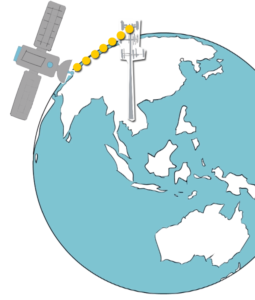 A communications satellite, parked in an orbit above the Earth, receives radio signals transmitted from a ground station which has a parabolic dish antenna aimed at it. The satellite amplifies the signals and re-transmits them to be received by appropriately aimed dishes located at multiple ground stations back on Earth.
A communications satellite, parked in an orbit above the Earth, receives radio signals transmitted from a ground station which has a parabolic dish antenna aimed at it. The satellite amplifies the signals and re-transmits them to be received by appropriately aimed dishes located at multiple ground stations back on Earth.
A comms satellite can create a vital communications link between widely spaced locations on Earth, thus providing high-bandwidth channels to carry voice, data, video or internet. Mining production, oil and gas exploration, and national security have all used satellite in conjunction with other technologies to bring communications to locations that are otherwise difficult or prohibitively expensive to reach using terrestrial technologies.

The satellites themselves can be parked in various types of orbits above the Earth. In a geosynchronous (GEO) orbit the satellite follows a high-altitude path (35,786 km (22,236 miles)) with a speed matching the earth’s rate of rotation. This allows the satellite to appear to be fixed over the same location on Earth.
A geostationary orbit is a special case of this type, where the path is directly above the Earth’s equator. Comms satellites are commonly placed in geostationary orbits since the satellite dishes on the ground can simply point to the same fixed position in the sky and don’t need constant re-alignment to track the satellite. GEO satellites provide unrivalled comms coverage, requiring only 3 or 4 to cover most of the Earth.
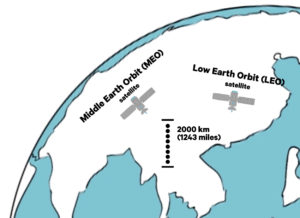 Closer to Earth, Middle Earth Orbit (MEO) satellites – circling at between 2,000 km (1,243 miles) and GEO altitudes – and Low Earth Orbit (LEO) satellites at still lower altitudes – need constant automatic tracking by earthbound dishes or require users to wait for the next available satellite to pass overhead.
Closer to Earth, Middle Earth Orbit (MEO) satellites – circling at between 2,000 km (1,243 miles) and GEO altitudes – and Low Earth Orbit (LEO) satellites at still lower altitudes – need constant automatic tracking by earthbound dishes or require users to wait for the next available satellite to pass overhead.
Communications satellites can use assorted radio and microwave frequencies, but international agreements aimed at minimizing communications chaos restrict their operation to specific bands (e.g. C-band (4-6 GHz), Ku (12-18 GHz) and Ka (26-40 GHz) bands).
Higher frequencies such as those in the Ka band provide greater bandwidth and better resolution but are more susceptible to ‘rain fade’ i.e. the absorption of radio signals by rain or snow in the atmosphere. Hence, in locations with regular rainfall or blizzards, the favored option is to use C-band frequencies despite their reduced bandwidth. This has made C-band almost too popular, with congestion in lower frequencies a major issue for satellite providers. (A less favored option is to use higher Ka or Ku frequencies but with more power to compensate for the signal loss due to rain fade.)
Bouncing a signal up to a satellite and down again takes time – up to half a second for a round trip for a GEO satellite and slightly less for MEO or LEO satellites closer to Earth. This high network latency, which affects all satellite communications, can rule out some applications, such as remote real-time control of machinery.
Although satellite networks are themselves extremely reliable (often quoting 99.7% availability), a satellite nevertheless represents a single point of failure, vulnerable to damage from orbiting debris or solar flares which can be difficult to repair. MEO and LEO satellites are more exposed to space debris and, unlike GEO satellites, experience atmospheric drag which causes their orbits to decay and leads to loss of altitude.

The rapid expansion of satellite communications has also created a growing problem of interference between adjacent satellites in an increasingly crowded sky. Where possible, a satellite-based system design should include provision for redundancy or alternative terrestrial communications to ensure access to communications is always available.
Portable Satellite Antenna and Modem
Satellite services such as BGAN (Broadband Global Area Network) offer briefcase-size portable battery-powered terminals into which a user can plug a phone, laptop or other smart device to make telephone calls or access applications on the Internet via theBritish company Inmarsat’s constellation of geosynchronous satellites. U.S. company Iridium offers similar services and products.
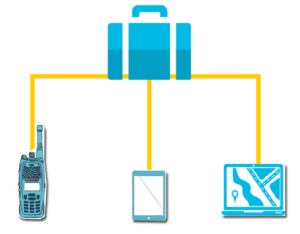
The BGAN plug and play terminals are easy to operate, needing only to be pointed in the general direction of the right satellite to get a connection at speeds for both uplink and downlink of up to 492 kb/s. While this may be a bit sluggish for web surfing, it is good enough to support basic Internet access, set up a VPN connection, send email, have two-way voice conversations, transfer files, and even some video conferencing and streaming IP.
The big issue with using services like these is cost, since you are paying either by flat rate or by the minute or by the megabyte. There are options for controlling cost, with companies offering different charging models, but to get the best of them it is necessary to have a clear idea of where satellite comms should be deployed as opposed to terrestrial alternatives.
VSAT
Alternatively, VSAT (Very Small Aperture Terminal) satellite communications systems can be set up with a two-way ground station connected to a dish antenna that points to or tracks a particular satellite.
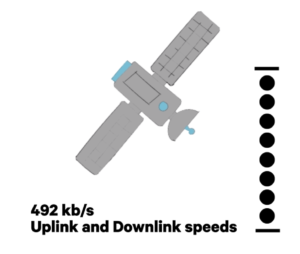
VSAT systems, which may be either fixed or mobile, can provide open standard IP-based Internet services such as email, web access, streaming video, voice over IP telephone, telemetry data transfer, or connection to business networks. VSAT data rates vary between 4 kb/s and 16 Mb/s, but unlike LMR, most VSATs are capable of supporting broadband data applications. VSAT sites can be networked together to connect back to a network operations center, command center or corporate headquarters.
VSAT equipment is available through a number of companies. VSAT is relatively inexpensive to buy, can be installed at a fixed site or in a vehicle, can be re-located quickly when needed, and is easy to operate. Most VSAT terminals operate in the more cost-effective Ku band or, increasingly, the Ka band.
Part of the reason for this lies in the convenience of their smaller dish antennas (74-120 cm. diameter). In contrast, C-band VSAT terminals can have dishes up to 4 meters in diameter – a bit too large for operation out of a typical vehicle!
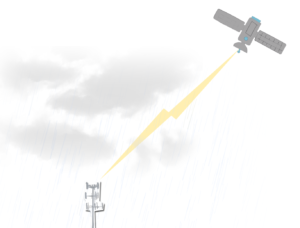 However, using VSAT requires a clear line of sight between the dish antenna and the satellite, which can be an issue for system design and operation. On a vessel rocking in a stormy sea, line-of-sight can be a struggle to achieve. Gyrostabilized antennas help, but in moderately rough conditions a lot of comms errors and retries can accumulate, degrading the usefulness of the connection. On land, a heavy tree canopy, new buildings, mine dumps, changes in local topography, or simply knocking the dish out of true can impede line-of-sight and thereby disrupt a VSAT connection.
However, using VSAT requires a clear line of sight between the dish antenna and the satellite, which can be an issue for system design and operation. On a vessel rocking in a stormy sea, line-of-sight can be a struggle to achieve. Gyrostabilized antennas help, but in moderately rough conditions a lot of comms errors and retries can accumulate, degrading the usefulness of the connection. On land, a heavy tree canopy, new buildings, mine dumps, changes in local topography, or simply knocking the dish out of true can impede line-of-sight and thereby disrupt a VSAT connection.
To provide wide-area linking across multiple sites (e.g. exploration camps) VSATs can be directly connected to each other in a mesh configuration. Or for centralized management and control each VSAT can be joined to a central hub ground station in star configuration. Both designs give additional routes for communication in case one or more of the VSATs fail or are unavailable.
By combining VSAT with other network bearers such as WiFi, cellular, LMR, or IP over ethernet, a variety of fully-functioned communication systems can be designed for remote locations without sacrificing connection to the rest of a critical communications system. Security is provided by encrypting voice and data communications as well as the ability to set up virtual private networks.
The big issue with using services like BGAN or Iridium or VSAT is cost, since you are paying either by a flat rate or by the minute or by the megabyte. The cost per megabyte is very high compared to terrestrial technologies. There are options for controlling cost, with companies offering different charging models, but to get the best of them it is necessary to have a clear idea of where satellite comms should be deployed as opposed to terrestrial alternatives.
Nevertheless, adding satellite as a bearer to a multi-technology solution, brings a whole new level of additional coverage, accessibility and communications flexibility.
PROS AND CONS OF LTE
Long Term Evolution or LTE is an open standard digital cellular technology that is already proving to be a game changer in critical communications as it offers a combination of features unmatched by any other wireless technology. These include:
- voice and very high capacity data,
- mobile communication with fast handover across the network,
- low latency,
- excellent resilience,
- built-in quality of service,
- low power consumption,
- and exceptional spectrum efficiency.
It is very fast, with an average network delay or latency that beats WiFi and is much lower than LMR.
A commercial version of LTE features in 4G smartphones and a later version called LTE Advanced provides even faster data rates and lower latency. Combined with low power consumption, real time machine-to-machine communications, monitoring and control through sensor networks, and smart automation become feasible with this kind of performance.

Whereas LMR has been optimized for voice, LTE is clearly optimized for data. In fact, voice over LTE (VoLTE) is a special form of voice over IP, with voice being converted into data packets and re-assembled as audible voice at the receiving end. To meet mission-critical requirements for voice communications requires more than basic VoLTE.
LMR voice services, including PTT, group, broadcast and emergency calling – remain the gold standard here. And while LTE standards have been expanded to encompass these services (e.g. MC-PTT), only evidence from real-life mission-critical operations can determine whether LTE standards developers and manufacturers have succeeded in matching LMR’s achievement.
At first glance LTE with its impressive data performance and low latency looks as though it could replace all other wireless technologies. But LTE too comes with some limitations. LTE cells are small, so significantly more towers are required to achieve the same coverage as LMR. This can be prohibitively expensive compared to either LMR or WiFi.
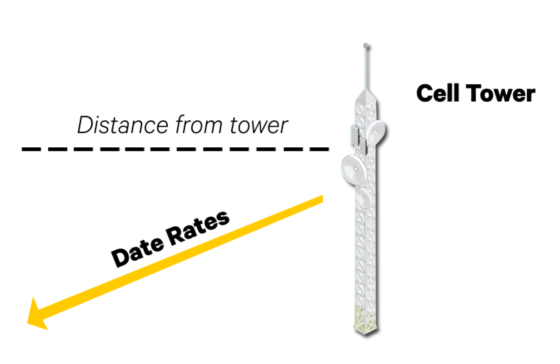
Also, LTE data rates decrease with distance from the tower, so the data performance you get at a cell boundary may be very much less then you would get next to a tower. And unlike LMR where range depends largely on radio signal propagation and is consistent throughout the cell, LTE coverage is bandwidth sensitive and depends on the network loading at any time. Applications don’t always work at the coverage boundary and – when network traffic is heavy – may fail altogether.
From a security perspective LTE is a better than WiFi. LTE data is encrypted and hacking LTE communication is more difficult, although successful attacks (such as a ‘Man-in-the-Middle’ exploit) are possible.
It is early days for what is undoubtedly a brilliant technology which is still evolving. As we will discuss in the next lesson The Future of LTE, there are features demanded by critical communications users that are either missing or under development, but over time LTE promises to become a dominant mission-critical technology.
WHICH WIRELESS BEARER SHOULD I CHOOSE?
Now that we’ve discussed the most common wireless voice and data bearers, you might be wondering which one you should choose?
 The key point is that you don’t need to choose the best bearer to do everything. Creating a monolithic system suitable for your entire organization is often too hard and involves making too many compromises in cost, availability, and performance.
The key point is that you don’t need to choose the best bearer to do everything. Creating a monolithic system suitable for your entire organization is often too hard and involves making too many compromises in cost, availability, and performance.
A close analysis of how the various groups in your organization interact and work can reveal the diversity and variability of your communications requirements over time. Matching bearers and devices to jobs makes better sense than a ‘one-size-fits-all’ approach.
This doesn’t mean you need to keep these different wireless networks completely separate, however. Defining an integration strategy that enables different bearers to be accessed by different devices as they are needed can improve the flexibility, coverage, resilience, and cost-effectiveness of your overall communications.
What is the Future of LTE?
One of the biggest movers and shakers in the Unified Critical Communications space is LTE. The broadband data capabilities could change the game, but will LTE ever replace LMR? Can First Responders rely on LTE to support their communications during emergencies or major events? Who is guiding the development of LTE? What’s the difference between Public and Private LTE?
All these questions and more will be answered in this lesson. Get started with the first topic below:
LTE AND THE MOBILE GENERATIONS
The LTE standards suite, which is setting the direction for future critical communications, is the work of a consortium of seven standards organizations called the 3GPP or third generation partnership program.
The consortium includes ETSI, the European Telecommunications Standards Institute, which is one of the largest standards bodies in the world. Since the end of the 90s, when the 3GPP consortium was formed, it has developed open standards for succession of LTE releases, guided by technical specifications set by ITU, the International Telecommunications Union for mobile cellular communications.
The evolution of mobile phone systems can be pictured in terms of generations:
0G– ‘Luggable’ briefcase mobile radio telephones (does anyone remember these?)
1G– Analog cellular phones
2G– Digital cellular phones
3G– High-speed digital cellular phones (including video comms)
4G– IP-based “anytime, anywhere” voice, data, and multimedia mobile comms at data rates that exceed 3G
5G– The Future. Still faster data rates, ultra-low latency, better mobility, more connections, and lower power consumption than 4G.
ITU’s technical specs set performance, data rate, and latency targets for 3G, 4G, and future 5G. The 3GPP designers have aimed to meet these standards. Each technology must improve on its predecessor. At the same time a major objective is, wherever possible, to make each technology backwards compatible with its predecessor so as minimize disruption when products entered the marketplace.
The first version of LTE (Release 8/9) exceeded the targets for 3G but did not reach the 4G targets. It is this version that you see in many early of the first ‘4G’ smartphones aimed at the consumer market. (Strictly speaking, these should be called ‘3.5G’ phones).
The next version, called LTE-Advanced (or LTE-A) achieves the 4G targets with data rates ten times faster than 3G. Newer 4G smartphones are already on LTE-A. It is this version which 3GPP is getting ready for critical communications users with features such as mission-critical PTT (MCPTT), MCDATA, MCVIDEO, and Direct Mode operation.
The final version of LTE is LTE Advanced Pro (LTE-A Pro) which sets the stage for 5G, the next generation of mobile communications for which standards have been finalized. LTE-A Pro is intended to be the LTE 4.5G technology transition to 5G, which uses some components from LTE and then other elements that are completely new. Equipment trials of LTE-A Pro and 5G have been underway and announcements of proposed commercial rollouts are already in the news.
WHAT CAN WE EXPECT FROM 5G?
Although built on LTE, 5G brings in a totally new air interface. 5G New Radio (5G NR) operates in millimeter wave (mmWave) frequencies (30-300GHz) and is a radical makeover of the radio access network.
This allows 5G to support a million connected devices per sq. km (0.386 sq. mi), offer data rates ten times faster than 4G, push massive data volumes, enable mobility up to 500 km/h, with an end-to-end latency of 2 milliseconds or less. Compare this with LMR latencies which average around 200 ms.
What do these insanely good specifications make possible? Some of the prospects mentioned are:
- Self-driving vehicles become realistic because 5G V2X (Vehicle to Everything) enables vehicles to communicate with each other to automatically avoid collisions.
- Industrial Internet of Things (IIoT) made real through the wireless connection of billions of low-cost, low-energy sensors and the real-time dynamic control and automation of industrial processes such as oil and mining production, manufacturing systems, energy distribution, and intelligent transport systems.
- Doctors performing remote robotic surgery.
- Artificial Intelligence applications to process video surveillance footage and react in real time.
- Using interactive virtual reality (VR) simulations to train firefighters on how to deal with complex fire incidents.
- Super-accurate and up-to-the second location tracking
- Augmented Reality (AR) goggles for ambulance services staff enabling a continuous overlay of medical and patient status information to be viewed while emergency assistance is delivered.
- Smart cities with massive sensor net connectivity supporting automated services and infrastructure.
The list goes on. But don’t expect miracles with the first appearance of 5G. These are enormously complex and high-risk applications with all the behavioral details, complementary technologies, and economics still to be worked out. 5G is simply part of the enabling infrastructure that makes the imaginable seem achievable within the next decade or so. It is seen as the enabling technology for the next industrial revolution, predicted to emerge from the Industrial Internet of Things (IIoT).
One of the fundamental deliverables of communications infrastructure is coverage. The astounding speed and bandwidth of 5G is founded on its use of millimeter wave radio signals. But these super-high frequencies have a short range, so 5G may only be able to reach a few hundred meters rather than propagating over rural distances.
Also, very high frequencies don’t penetrate obstacles very well, so everything from concrete walls to tree leaves may disrupt signals. To achieve the ‘everywhere – anywhere’ coverage that critical communications expects, lots and lots of small cells, densely clustered, will need to be installed both inside and outside buildings. This is very different from LMR’s use of a much smaller number of tall radio towers outdoors to achieve coverage. So, there is still much investigation and trialing of 5G coverage ahead before we can be confident that 5G is ready for prime time.
COMMERCIAL PUBLIC LTE VS PRIVATE LTE VS PUBLIC SAFETY MOBILE BROADBAND
Mission critical users who want to take advantage of mobile broadband have several choices. In this topic, we’ll discuss the top 3.
Commercial Public LTE
Commercial cellular providers offer the vast majority of LTE services currently available to the public and businesses.
In the US, Verizon Wireless, AT&T, T-Mobile, Sprint and U.S. Cellular are the only providers that operate their own networks. Economies of scale permit them to take on the heavy cost of building and maintaining these networks to deliver nationwide coverage and a platform for mobile data services and applications to a vast market of subscribers on domestic and business plans.
Cell phones are relatively inexpensive (compared to LMR radios), pocket-friendly, and generally high quality with user interfaces that look good and are easy to use. It’s no wonder that businesses and even several critical communications users have had second thoughts about the cost and effort of operating their own communications systems.
For some it may be the right move to jump onto a commercial system. To others, however, this move entails giving up too much control. The logic is simple: if you don’t own the system, you can’t control it, and if you can’t control it, you can’t absolutely rely on it. To give some examples of where issues could arise:
- Coverage, for instance, is determined by where cellular companies see it worthwhile to provide. A public safety entity in a rural area has different priorities and may require coverage in regions that have little economic potential. Call dropouts and loss of service can be expected.
- Users of commercial systems share resources with everyone else. If the network is overloaded with rush hour, video-sharing, an emergency or a hacking attack, everyone suffers the performance hit, including business and organizational users. A public network carries a lot of public traffic and applications irrelevant to business or critical users, who nevertheless have little control over the prioritization of traffic when things get heavy.
- Maintenance and upgrades are performed according to schedules determined by the cellular provider, not its customers. However accountable the provider may be and however worthy the service level agreements, in the end the maintenance schedule belongs to the provider rather than the customer.
- When a cellular network crashes, or a key site loses power, or the systems becomes otherwise unavailable, all communications stop for all until normal service is restored. There is no backup service to kick in until then.
Private LTE
Private LTE, as the name implies, is a dedicated LTE network that serves a specific enterprise business, government agency or educational outfit, who can own and operate the system or who may instead outsource to a commercial mobile operator or third-party network provider. The system is entirely separate from public commercial networks. Private LTE enables an organization to have the benefits of LTE without losing so much control. Outsourcing removes the need for total ownership or assuming full responsibility for operating the system.
Since a private LTE system runs on its own dedicated equipment, its coverage, performance, and security are independent of public LTE services. Large mining companies in Australia are investing in private LTE systems that are optimized for mining traffic and applications. Backup communications, whether using LTE or another technology will be part of their system design.
A major constraint on private LTE is the availability of suitable radio spectrum. In many countries existing licensed spectrum is already congested. Depending on where you are, this can mean either that you need to wait until new LTE frequencies are allocated, or you need to pay a premium to buy into an existing block of spectrum, or you will need to wait until someone else gives up their frequencies. Alternatives include using unlicensed spectrum, such as 5GHz, with an LTE-based technology such as MulteFire. Or, using shared spectrum e.g. through the Citizen’s Broadband Radio Service (CBRS) in the U.S., or through the Licensed Shared Access (LSA) model being tested in Europe.
Public Safety Mobile Broadband networks
Public Safety Mobile Broadband networks are a specific type of private LTE network – one dedicated to public safety and first responders. They are not available to other types of critical communications users and are generally government-funded. Examples include FirstNet in the U.S., Emergency Service Network (ESN) in the United Kingdom, and SafeNet in South Korea. Australia is also in the early planning stages for a Public Safety Mobile Broadband (PSMB) network. The aim of such systems is to provide public safety agencies something they did not get out of LMR namely, secure, nationwide, interoperable communications with voice and broadband data.
In the U.S. FirstNet is an independent authority within the National Telecommunications and Information Administration (NTIA), an agency of the U.S. Department of Commerce. The FirstNet Authority contracted private mobile operator AT&T to build and operate the LTE network for the lifetime of its contract. Public safety agencies such as state patrols, fire department, and federal departments sign up as subscribers to use the FirstNet system.
What happens to existing public safety communications systems? If they are LTE networks, such as Los Angeles’ LA-RICS LTE system, the equipment will be transferred into FirstNet (or its non-US equivalent). If the existing network is not LTE, such as the TETRA system used by the UK Police, it will be de-commissioned and officers will need to work with a whole new technology.
IS COMMERCIAL PTTOC MISSION CRITICAL?
Public Safety embraced LMR for its ability to provide speedy and reliable narrowband voice communications at the touch of a PTT button. Push-to-Talk Over Cellular (PTToC) tries to emulate the behavior of LMR’s PTT over cellular networks and commercial versions have been around since the days of Nextel’s iDEN. PTT, you will remember, is a must-have feature for critical communications. Already PTToC over LTE is being used to replace LMR in non-mission-critical scenarios. LTE has the data rates and speed to do this, but is PTToC really mission-critical?
Three classes of PTToC exist, two being types of commercial product and one being an open standard.
Carrier-based PTToC services – offered by mobile network operators (e.g. AT&T, Kodiak, Verizon and Sprint) and tightly integrated with their networks.
Over-the-Top (OTT PTToC) products – each of which run as a mission-critical application (e.g. EsChat, Harris BeON, Tait TeamPTT, Motorola WAVE) over the top of a network and is thus independent of any carrier network.
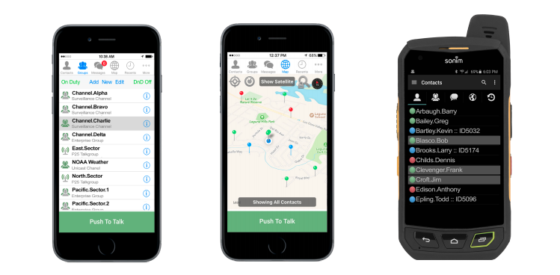
Mission-Critical PTT (MCPTT) – which is the name of a 3GPP initiative based on the Open Mobile Alliance’s OMA-POC technology to define a mission-critical open standard for PTT over LTE.
Non-mission-critical users, as well as some public safety agencies, have taken up carrier-based PTToC as an alternative to LMR. You can see the attraction. It runs on standard smartphones, which are a lot less expensive than public safety grade radios. And instead of owning a comms system, organization can purchase subscriptions and maintenance contracts from a commercial provider. Thanks to its tight network integration, this form of PTToC is fast, runs standard call types, and (maybe with an additional service) can handle a saturated network.
But there is a downside as well. The integration of a carrier-based PTToC offering is challenging both technically and commercially. Engineering reasons can prevent the connection of PTToC from Company A’s carrier to talk groups on Company B’s network and vice versa. The technical incompatibility of the two PTToC carrier integrations makes cross-network connection impossible.
Commercial barriers also exist. Even when two carrier integrations are technically compatible, Company A may not permit its subscribers to use its PTToC to connect to subscribers on another company’s network. It’s business and their proprietary product. Just as it is business for them to restrict the offer of PTToC to a limited range of smartphones. This will not work for mission-critical users, who need the ability to cross-network PTT with something better than the ‘best effort’ service that is standard for commercial networks.
Equally serious is the inability of carrier-based PTToC to support Direct Mode communication, which is direct radio-to-radio (also called ‘simplex’) communication without involving a network. Firefighters depend on Direct Mode to communicate with each other when they are cut off from their network. Carrier-based PTToC is, by design, always mediated by an LTE network.
OTT PTToC overcomes some of these issues. Running as an application over the top of the network, it is to use the phrase ‘carrier-agnostic’ and does not depend on any specific carrier or device. You can therefore PTToC across networks with a wider variety of devices. Since nearly all OTT PTT applications can work on multiple broadband access technologies such as Wi-Fi, LTE and even 3G data on multiple platforms like Chrome, iOS, Android and Windows, this form of PTT is hugely flexible.
However, once you choose your OTT application, you are then locked into a proprietary ecosystem where everyone needs to have the same application. This means that an OTT app from one vendor cannot directly communicate to another vendor’s OTT PTT system, which undercuts the ability of mission-critical agencies to interoperate. Maybe some form of bridging or console patching can serve as a workaround, but the basic problem is the proprietary nature of OTT applications. Moreover, since OTT apps need a network to work, they, like their carrier-based counterparts, are handicapped by an inability to support Direct Mode communications.
What is the Future of LTE?
MCPTT AND MISSION CRITICAL
MCPTT is 3GPP’s answer to the issues discussed in the previous topic, namely, an open standard PTT over LTE specification that meets the mission-critical requirements as identified in the U.S. by the National Public Safety Telecommunications Council (NPSTC), including a plan for integrating LMR and LTE.
In response, both carrier-based and OTT PTToC vendors have announced plans to modify or upgrade their own offerings to the MCPTT standard and FirstNet/AT&T has insisted that its PTT will be fully compliant. Deployments of MCPTT to public safety have begun, so MCPTT will be tested in real life situations.
Does this mean that the issue has been settled about whether PTToC is mission-critical? Not quite.
First, let’s remember that most of the devices available today for MCPTT are standard consumer products. Not public safety grade, not rugged, and not built with dedicated PTT or emergency alert buttons. Over time this will undoubtedly change.
Second, unless MCPTT runs over LTE networks that support quality of service, call prioritization and call pre-emption, the reliability and availability of communication will still not meet public safety expectations. FirstNet does have the right features, but many public networks do not.
Third, there is the question of interoperability between LTE networks and between LTE and legacy LMR. While FirstNet provides interoperable communications for all of its subscribers, the ability of FirstNet subscribers to MCPTT outside of FirstNet, either to other LTE networks or to legacy LMR systems is a point of continuing discussion.
Finally, Direct Mode for LTE is still a challenge. To meet this 3GPP created a specification for LTE Proximity Services (ProSe) that define how to achieve device-to-device communications for voice (MCPTT), data (MCDATA) and video (MCVIDEO). However, typical LTE devices are designed to transmit at low power (generally around a quarter of a watt) at high frequencies through internal antennas, so the range of ProSe is quite limited. LMR radios, with higher transmission power, external antennas, and use of lower frequencies (with superior propagation) do a lot better in Direct Mode.
In the US, FirstNet will be a powerful promoter and proving ground for MCPTT and provide the necessary experience for future improvements to PTT over LTE.
So, although PTT over LTE is not yet fully mission-critical, the gap is closing fast.
WILL LTE REPLACE LMR?
Given the frantic pace of LTE development and the falling cost of ownership, the hot question of the moment is ‘Will LTE replace LMR?’. It may surprise you to know that the consensus among those with the biggest stakeholders in mission-critical LTE is that, while they anticipate LTE (and eventually 5G) to take over many of the functions of LMR, we should expect to see the continued use of LMR for many years to come. Andy Seybold explains the situation well in his article on LMR and LTE.
Even the operators of these major LTE systems warn that that public safety agencies cannot rely on LTE alone. They see LMR as a necessary element of public safety critical communications for the foreseeable future. To quote a statement from FirstNet:
“First responders currently use land mobile radio (LMR) networks for mission critical voice communications. When the nationwide public safety broadband network (NPSBN) is launched, it will not replace their LMR systems. The network is expected to initially transmit data, video, and other high-speed features, such as location information and streaming video, as well as non-mission critical voice. Public safety entities will continue to use LMR networks for their mission critical voice needs.”
One reason is that for all critical communications users (not just public safety), LMR remains the technology which is still available when others have failed. LMR was designed with a variety of failsafe options to preserve communications, even when major components of the network are damaged or become inoperable.
Thus, if the core network fails in a multi-site LMR system, each working individual site can switch to local standalone operation and can still connect any units within range. And if all sites are down, units can still talk to each other in direct (simplex/talkaround) mode without a network.
Public safety relies on these fallbacks, which at this stage LTE networks struggle to offer. LTE standards (e.g. ProSe for Direct Mode, IOPS (Isolated E-UTRAN Operation for Public Safety) for standalone site comms) have been developed to address these critical concerns, but it is early days for the commercial products. A great deal of real-life testing lies ahead before public safety feels totally safe with the delivered goods.
So far, LMR is the technology that comes closest to delivering public safety grade systems. It has taken a few decades of field and interoperability testing, customer experience, standards and product refinement to reach this point. LTE, in the view of its developers and organization users, is still in learning mode. Their strong recommendation is to retain LMR for mission-critical voice alongside LTE for broadband data.
This recommendation has an underlying message: ‘No technology is good at everything, so why stick with just one?’
LMR has been battle-tested in emergency situations and its combination of wide-area voice coverage where no telco wants to tread, tried-and-true voice call services, ultra-reliable networks with built-in failsafe, and a better handle on interoperability than its competitors. LTE brings dazzling broadband data performance, low latency, a ready platform for the development of custom applications, and a path to the future.
The challenge will be how to merge and manage these technologies, to unify them, without compromising the benefits of either.
The Benefits of Unified Critical Communications
There is a lot of content in this series of lessons, but that’s because there are so many benefits to unified critical communications. In this section, we’ll take a look at some high level benefits, and then apply them to many different industries. You’re welcome to watch all of them, or focus on your industry. Either way, there is a lot Unified Critical Communications can offer you and your organization.
- What is Unified Critical Communications?
- How Does Unified Critical Communications Work?
- What Benefits Can You Get from Unified Critical Communications?
- Benefits of Unified Critical Communications for Law Enforcement
- Benefits of Unified Critical Communications for Fire Services
- Benefits of Unified Critical Communications for Emergency Medical Services
- Benefits of Unified Critical Communications for Utilities
- Benefits of Unified Critical Communications for Transport
- Benefits of Unified Critical Communications for Oil and Gas
- Benefits of Unified Critical Communications for Mining
- Summary of the Benefits of Unified Critical Communications
WHAT IS UNIFIED CRITICAL COMMUNICATIONS?
Unified Critical Communications (UCC) is an approach that is both radical, and deceptively simple. Unlike traditional reliance on a single communications technology, Unified Critical Communications combines the strengths of a diverse range of technologies, while mitigating their individual weaknesses. It can:
- Replace traditional single-technology solutions with multiple communications bearers,
- Open up the choice of a much wider range of equipment types and vendors,
- Integrate different networks so that they are managed as one,
- Deliver communications dynamically via multiple networks, ensuring that communications always get through,
- Future-proof systems by enabling new bearers and technologies to be adding as and when required.
Unified Critical Communications is not a new technology, but an innovative integration platform.
The basic idea is that various different bearers, devices, and applications can be integrated at the network level to present a consistent, unified user interface and experience. This allows voice, data, video, mobility, and services to be seamlessly unified across a multi-bearer network acting as though it was a uniform managed system.
As a critical communications user, you have probably invested in multiple technologies such as LMR, WiFi, 3G or 4G cellular, and connection to your back-office and dispatch systems. Why not continue to use these, especially if they can be made to work better?
Investing in a new technology that promises to do everything is a considerable gamble. It requires a costly changeout of equipment, training, and processes, and risks that existing processes and systems may be disrupted or fail. Unlike smartphone consumers, critical communications operators cannot afford interruptions to their communications.
Of course, a basic integration of different bearers has been carried out before. Proprietary bridges or gateways have commonly been used to combine different technologies, enabling a call from one LMR technology to cross the bridge to a system using a different LMR technology. Interoperability standards have also created interfaces that facilitate cross-network communication.
However, these real-life integrations generally do not go far enough. Often, only a limited selection of technologies can be combined in this manner. The net result can be a collection of communications subsystems that appear to be integrated yet, being only loosely connected, are managed separately. Getting them to work together – coordinating overall performance, monitoring security, and administering consistent access control – is complex and costly. Moreover, integration through proprietary interfaces can severely constrain interoperability, locking organizations into buying only from vendors that support that proprietary connectivity.
Moving beyond those piecemeal integrations, Unified Critical Communications seamlessly integrates any combination of voice, data, text, images, or video. The system itself automatically selects the best network to deliver these quickly, reliably and securely across various devices, endpoints, and applications – without user input. UCC dynamically adopts the best delivery method available at that moment, whether it is LMR, WiFi, 3G/4G cellular, Private LTE, satellite, etc. Thus, UCC supports the most appropriate aspects of existing technologies while accommodating future developments such as 5G.
HOW DOES UNIFIED CRITICAL COMMUNICATIONS WORK?
Through a mixture of hardware and software a Unified Critical Communications platform can be implemented in various ways, either as a centralized system hosted on customer premises or as a cloud-based service, or de-centralized as a mobile platform connecting voice and data networks, with Internet access to an organization’s home network via LTE broadband.
Without getting into the design details of specific products, we can identify some common features of current UCC platforms
The basic idea is to create a network of networks through LMR, LTE broadband, WiFi and Bluetooth and any other supported technology (e.g. satellite). Open standard IP protocols provide much of the essential glue.
A UCC platform interconnects all these different bearers, enabling any device to interoperate with any other device in the system. So, services and applications available on each technology can become available to everybody.
A perfect example is Push-to-Talk over cellular, which allows users of smart devices (whether Android or Apple, smartphone, tablet or laptop) access to LMR services such as individual and group calls. And it works the other way, too: LMR users can make calls to these cellular devices.
One consequence is that a group call can span multiple technologies and multiple devices. The talkgroup is defined to include users of different devices.
To manage all the users and devices on this network of networks, the UCC platform provide a means of adding, storing, and removing device-independent user IDs. Each user ID will have associated information about groups they belong to, group affiliations, access rights etc. Since groups may need to be created or changed on the fly, there will also be a database for managing groups.
For critical communications to operate without a hitch, the administration of user data and group membership needs to be kept up to date, with any changes made instantly, such as through Over-the-Air Programming (OTAP) which can re-program a fleet of devices remotely over the air.
When you logon to a UCC network with your user ID, several things happen. A registration process begins which includes an authentication check by the network against a database of permitted user ids, an authorization of access to permitted services, a logging of your entry to the UCC network, the detection of your current location, and an advertisement of your presence on the system as available for communications.
Security is mandatory for critical communications, so these checks are a central element of a UCC platform, which must also provide end-to-end securing of voice and data transmissions, a facility for call recording and logging, as well as accounting of any other communications activity on the network.
So, a UCC platform must maintain and merge the bearer connections, manage users and groups across various devices, arbitrate cross-network calls, and provide essential security coupled with audit services. Surprisingly, all this does not require a lot of hardware. At its most compact – for instance, Tait Unified Vehicle – a unified critical communications platform can fit into the space of a car radio.
The Benefits of Unified Critical Communications
WHAT BENEFITS CAN YOU GET FROM UNIFIED CRITICAL COMMUNICATIONS?
By combining the strengths of multiple bearer networks to ensure that your communications always get through, Unified Critical Communications can deliver a package of benefits to your organization that no single technology can match.
UCC enables fast voice and broadband data communications on almost any device, across all major networks to anybody, anywhere. With the ability to share text, images, video, audio and other critical information, and to access data applications that make sense of this information, everyone in your organization is better connected, better informed, and better equipped to collaborate quickly and effectively in both day-to-day business and emergencies.
Some examples illustrate how unifying communications can lift productivity, improve staff health and safety, enhance interoperability, and increase communications resilience.
The next few topics will explore examples in the following industries:
- Law Enforcement
- Fire Services
- Emergency Medical Services
- Utilities
- Transport
- Oil & Gas
- Mining
Feel free to watch them all, or simply choose the industries that you find most interesting.
BENEFITS OF UNIFIED CRITICAL COMMUNICATIONS FOR LAW ENFORCEMENT
Group calls are critical for public safety. UCC takes this to a whole new level by making it possible to create groups that span multiple technologies and devices. If you add PTToC as a feature that can run on all sorts of devices, then there are always alternative fast routes for a call. Response times are minimized, headquarters and dispatch are in immediate contact, and officers are better protected.
Moreover, having a wider array of communications technologies at hand means that there are more interoperability options for collaborating with outside groups when responding to multi-agency events that involve other law enforcement agencies, fire, and medical support.
With UCC, officers can take advantage of broadband access without giving up their trusted LMR radios. Real-time geolocation, bodycam video, maps and images on demand, license plate reading, as well as warrant & arrest database queries can all be exchanged with HQ from inside or outside the police car while maintaining voice contact with dispatch. This significantly improves the situational awareness of officers when they arrive at an incident scene.
Broadband access can also enhance situational awareness by putting law enforcement data applications in the hands of frontline officers e.g. connecting them to CAD systems which use address lookups and geofencing alerts to automatically display police intelligence data in real time as officers travel through specific locations.
WiFi data applications presented through a UCC system can even automate routine and time- consuming tasks such as tracking and managing assets or updating the settings and software of comms devices.
In effect, UCC turns each officer or police vehicle into a kind of communications hub.
BENEFITS OF UNIFIED CRITICAL COMMUNICATIONS FOR FIRE SERVICES
It is no surprise that UCC can help fireground communications in ways that are similar to the UCC benefits derived by Law Enforcement. Multi-device talkgroups, automated asset tracking, keeping everybody connected and better informed, and the positive effect on response times are benefits that Fire, too, can enjoy.
Where Fire differs is that fire events drive a different structure of communications. Policing involves a moderate level of 24/7 patrolling communications with small bursts of intensive activity when incidents arise. Fire communications are fairly quiet until a fire is reported. Then it is ‘all go’ as appliances race to the fire scene, a fireground command post is set up, critical data about the fire scene pours in, an initial size-up is made, a plan of attack is shared, and men and equipment are deployed to bring the blaze under control. The incident commander is in contact with all appliances at the scene and in transit, with firefighters via LMR inside the fire and – via the agency comms network – with HQ. Unified Critical Communications mean that fire commanders and personnel do not lose precious time fighting with technology rather than fires.
Frontline staff still rely on LMR which allows them to intercommunicate using talk around (Direct Mode) even when contact with the command post network is lost. But fire communications systems have ceased to be LMR-only as data and data applications have brought CAD-CAM intelligence, GIS maps, images, and real-time video directly to the command post.
Fires can change their behavior quickly, so close monitoring of the fire, the location and status of firefighters is essential for improving situational awareness and obtaining a positive outcome. Better information, constantly updated and widely shared, can make all the difference. This is easier to achieve when a single device can be enabled on multiple talk paths.
Modern personal protection equipment (PPE) increasingly includes some form of physiological and fatigue monitoring integrated with location tracking (via Bluetooth and WiFi) into a firefighter’s comms unit. Cardiac arrest is still the biggest cause of firefighter casualties, so a system which identifies individuals under stress and alerts the command post of the need to get them out can reduce firefighting casualties dramatically.
With UCC, a command post vehicle can become a communications hub or vehicle area network, combining and coordinating the communications of multiple types and devices, interoperating with EMS or other fire services, and even providing local area communications and applications when contact with the agency network is lost or out of range.
BENEFITS OF UNIFIED CRITICAL COMMUNICATIONS FOR EMERGENCY MEDICAL SERVICES
Ambulance and Emergency Medical Services (EMS) see their mission changing from the transportation of patients to hospitals for emergency medical care to one of delivering more advanced medical care directly to the patient. In a race against time, faster response and more appropriate medical assistance lead to better patient outcomes.
This concept, which one leader in ambulance services has called ‘the Connected Clinician’, relies on a radical revision of traditional ambulance communications. It would enable mission-critical voice, video, data, and EMS applications to be accessed through smart technologies using any device, any bearer, at any time. UCC is perfect for making the Connected Clinician a reality.
By combining, enhancing, and unifying the management of technologies currently used in ambulances – radio, mobile data terminals, tablets, smartphones – UCC allows paramedics, who are already working under stress, to focus on ambulance patients rather than communications equipment.
Since a single device can be enabled on multiple talk paths – which may be LMR, LTE, WiFi or satellite – UCC can reduce the number of different devices that must be present in an ambulance and can create a uniform user interface and standardized actions to operate them.
WiFi inside the ambulance can be used to connect the multiple devices that are retained, including the possibility of ambulance personnel bringing their own comms devices (even smart watches), as well as enabling simplified asset tracking and management.
LTE broadband access inside UCC supports faster GPS/AVL services, especially if tied into traffic condition and weather report updates, ensuring that ambulances get to the nearest medical center by the best route.
Broadband access also delivers cardiac monitoring and medical telemetry data in real time to the medical center while data applications hosted in the ambulance automatically access a patient’s electronic medical records (eMR), perform local processing, and present reports to paramedics who, via headsets and body cams, are in consultation with medical center specialists.
Ambulances therefore become a key component in a coordinated first response operation that can also include comms-connected motorcycles, medical aircraft, and helicopters. In the Connected Clinician vision, an ambulance can act as a communications hub hosting a multi-network terminal, a WiFi mobile hotspot, with a local processing capability that can support advanced mobile services such as stroke scanning and diagnostics.
To expand the range of advanced EMS, the Connected Clinician model also looks for future-proofed solutions that can keep pace with communications innovations such as 5G. If an ambulance and highly trained paramedics can perform medical interventions that are normally carried out in an emergency department, then some of the load of over-stretched hospital services can be assumed by ambulance services instead.
With its ability to add bearers as required, a UCC network can support both existing systems and future EMS possibilities that 5G opens up.
BENEFITS OF UNIFIED CRITICAL COMMUNICATIONS FOR UTILITIES
Utility companies face major challenges providing efficient and reliable electric power, water and gas services. Not only do they need to maintain large distribution networks, for which worker safety and cost are big concerns, but a changing marketplace with new diverse generation options, new demands (such as the support of electric vehicle charging), environmental and security issues, and shifts in demand patterns across domestic and business users mean that utilities need to become smarter.
They must become more responsive, more flexible, more efficient, safer, greener, and more cost-effective. Modern technology coupled with integrated communications can make this happen.
Utilities are moving to smart distribution systems through grid modernization by deploying smart meters and remote-control switches. These switches allow operators to monitor and control system operations from operations centers in real time, reducing the need to send crews to gather field data and operate devices on site.
Determining fault locations, which might otherwise take hours, can be dramatically reduced through smart grid applications that automate fault location, isolation and restoration (FLISR) and are integrated into advanced outage management and distribution management systems. Enhanced telemetry and automated analysis also make predictive maintenance possible.
The future of utilities is to use real-time monitoring and remote control of both the distribution and transmission networks to fully automate distribution. Fast, secure, ultra-reliable, high bandwidth communications are essential to make this future a reality.
With UCC the multiple network systems, which combine the capabilities of LMR, LTE, cellular, WiFi (even satellite for geographically remote locations) can offer distribution operators outstanding improvements in reliability and coverage over traditional radio-only communications. The ability to add new bearers such as 5G without impacting existing communications future-proofs the benefits gained by integrating communications now.
When crews are sent out for fault identification or maintenance, a communications advantage helps their situational awareness. They can arrive better informed by the outage management system, better equipped through automatic asset management, and better connected through UCC to deal with the situation at hand.
A UCC platform in the service vehicle brings reliable and resilient multi-device group communications to the field location and, via the backhaul, to the central office. Two-way voice consultation, the exchange of field data, images or videos with the operations center, and connectivity to power line sensors can speed up fault resolution and service restoration.
It also means that, field crews working in dangerous conditions are better protected through GPS/AVL, location tracking and automatic safety features built into their comms devices. For example, if a line worker is in danger and unable to manually call for help, automated safety features like Man Down and Lone Worker will immediately send an alarm to dispatch which will know where to render emergency assistance.
Smart metering presents another tool for real-time monitoring of system operations by collecting data on customer energy consumption and using built-in two-way communication to automatically transmit this information to a distribution operating center where it is processed for customer billing, outage management, and other operational purposes. Applications of smart metering include:
- Automated customer billing,
- Volt/VAR control (VVC) to automatically manage both reactive power (VAR) and voltage levels over the distribution network across diverse loading conditions,
- Conservation voltage reduction (CVR) without impacting customers, to reduce overall energy usage in the utility system by adjusting voltages dynamically,
- Demand response (DR), to enable customers to reduce or shift their electricity usage at peak periods in response to time-based rates or other forms of financial incentives,
- Load modeling and forecasting for assisting system operations and resource planning.
To gain these benefits, utilities will need to move beyond single-technology communications, not by abandoning their LMR investment, but by including it within an integrated communications solution.
BENEFITS OF UNIFIED CRITICAL COMMUNICATIONS FOR TRANSPORT
Public transport systems need to increase patronage and trim costs to help cities reduce road congestion and manage the transportation requirements of growing urban populations. A UCC solution can help with both patronage and costs.
Backed by the International Association of Public Transport (UITP) and the Information Technology for Public Transport (ITxPT) association, Europe is driving a revolutionary initiative to develop a modular plug & play IT architecture for public transport based on open standards. This would replace existing proprietary systems that are hardware-based, expensive to maintain, upgrade, or remove, and do not scale.
Trials of this new architecture are currently underway in the UK at Transport for London (TfL). If successful, it will become the new standard for European public transport. A key ingredient is a multi-bearer communications gateway installed in each bus. The UK trials are using a UCC platform inside every bus to test its ability to provide bearer services within the IP-connected bus and between the bus and the control center. This vehicle area network helps to supports various specific benefits, including:
- Interoperability between bus location systems and multiple back-offices (e.g. belonging to different bus operators),
- Bluetooth automatic passenger counting,
- Smart ticketing systems that can handle a variety of ticket types and media,
- Access to custom on-board IT applications,
- Reliable and more up-to-the minute timetables and real-time passenger information (RTPI) and electronic signage,
- Integrated transport (including buses, trams, and trains) for trips across different connections and even different operators,
- Better safety and security for drivers, street teams & passenger through resilient voice communications, video surveillance and on-board cameras,
- Predictive maintenance enabled by vehicle telematics and tele-diagnostics.
Open standard interfaces, IP protocols, and the capabilities of converged wireless communications over multiple devices provide the essential connectivity that holds this innovative architecture together to deliver these improved services across a whole continent.
And more generally, it promises to create a public transport system that is more efficient, more flexible, cheaper to run, greener, and gives passengers a better experience.
BENEFITS OF UNIFIED CRITICAL COMMUNICATIONS FOR OIL AND GAS
It’s been tough time for the oil and gas industry as volatile markets, rising costs, declining productivity and a shrinking skilled workforce take their toll on business. The concept of a Digital Oil Field promises a way out, but it depends crucially on integrated communications. O&G companies are looking to integrate their business operations using advances in communications technology to improve productivity, control costs, increase reliability, security and worker safety. But no single technology can fully service this integration, when companies must consider cost, coverage, spectrum availability, bandwidth, latency, ease of deployment, and flexibility.
The solution lies in unifying multiple technologies: an integrated mix of different communications technologies, ranging from VSAT satellite, LTE broadband, WiFi, cellular, to digital LMR, each with its own strengths and weaknesses.
By unifying their critical communications, they stand to gain:
- Greater coverage and communications resilience throughout the entire range of their operations from upstream exploration and production to midstream pipeline transport, processing and storage, to downstream refining and distribution, all the way from field locations to corporate headquarters,
- More efficient operations through a greater use of advanced telemetry, sensor networks, remote monitoring and control of equipment,
- Increased end user productivity through multi-device team communications where the exchange of voice consultations, field data, images and video enable collaborations and faster decision-making among skilled staff wherever they may be based,
- Improved worker safety and security with – emergency communications, go-ahead message broadcasts across diverse bearer networks, integrated communications security, video protection, and environment monitoring,
- Huge cost reductions in areas such as exploration, field development, and production operations, which are historically the riskiest and most expensive for a company. Using field automation, workforce management applications and automated asset management can slash downtime and shorten schedules,
- Find additional reserves and potential sources of income either by extending the lifetime of ‘brown fields’ (which previously would have reached the end of their economic life) or by undertaking more complex projects to access reserves in difficult environments.
The future goal is to develop a Digital Oilfield using the Industrial Internet of Things to integrate, automate, and optimize upstream operations. This involves utilizing machine-to-machine communications among millions of wirelessly connected smart elements such as sensors, measuring devices, and actuators embedded in drills or wellheads which exchange data in real time.
Specialized applications send the combined and integrated sensor data to servers for storage, retrieval, processing and analysis. Field data is processed continuously in real time, with smart applications automating decision-making, performing predictive analyses, reacting to alarms, and monitoring and controlling production process – with or without human intervention.
Field telecommunications are critical to the success of Digital Oilfield services. In the near future, extraction companies will be rethinking the plethora of single-function bearers and applications that many exploration and extraction companies currently operate.
Rather, the future for the Digital Oilfield is to deliver business efficiencies, by bringing the field to the operator rather than the operator to the field. Underlying any Digital Oilfield is an integrated communications system that is reliable, resilient, cost-effective, robust, and secure.
BENEFITS OF UNIFIED CRITICAL COMMUNICATIONS FOR MINING
Mining companies face challenges similar to those encountered by the oil and gas industry, namely volatile markets, rising costs, falling revenue, declining productivity, a shrinking skilled workforce, and the demand for environmentally sustainable practices.
Their operations may extend over geographically scattered mine sites including both surface pits and underground and rail or road transport to ports. The aim is to bring together all business operations, connected by a communication system that can handle traditional voice and data as well as the remote oversight and operational control over vast areas as envisioned by the Industrial Internet of Things.
To make this happen, mining needs communications solutions that can offer the immense coverage of satellite, the reliability and worker protection of LMR, the high bandwidth and low latency of LTE, and the convenience of WiFi, all available through the assorted devices employed by mine personnel. Only a unified critical communications solution can fit these requirements.
Larger companies have already leveraged converged communications and cutting-edge automation technology to develop mining applications that are improving productivity and efficiency, slashing costs, reducing environmental impact, and increasing worker health and safety. Some specific examples are:
Improving worker health and safety
- Collision avoidance systems using mobile WiFi hotspots on moving equipment, location tracking and geofencing alerts,
- Multi-bearer data and voice communications from underground coalface to surface operations to eliminate communication blind spots,
- Visualizations and dynamic modelling of changes in mines using seismic data to manage risk
- Physiological monitoring, fatigue management and location tracking of underground miners,
- Sensor networks monitoring levels of dangerous gases in underground mines,
- Better blasting operations safety through hazard notifications triggered by geofenced blast zones and use of remote LMR controlled blast control,
- Employing automatic equipment such as drilling rigs for hazardous operations.
Reducing environmental impact
- Optimizing mining processes to minimize the use of resources such as water for tailing ponds, decrease energy consumption,
- Applications to accurately tally toxic mining waste,
- Running material flow analyses to track the physical flows of natural resources through extraction, production, fabrication, use and recycling, and final disposal, accounting for both the gains and losses occurring throughout the supply chain,
- Geotechnical and environmental monitoring.
Increasing productivity
- Automatic collection and analysis of telemetry and tele-diagnostics data on equipment status and performance to predict and respond to equipment faults before they impact on production,
- Over-the-air machine monitoring and updates,
- Real-time CCTV or UAV surveillance of production system performance, tailings, ore passes as well as using UAV in addition to exploration crews for prospecting,
- Use of remotely operated driverless ore trains and trucks.
Improving efficiency
- On-site staff and offsite experts collaborate via voice, data, and real-time video, to improve the quality and speed of decision-making,
- Integrating representations of the mine sites, production, injection network, wells, economics and planning tools, modelling the entire field so operators can optimize production across multiple sites, optimize the entire supply chain, and run analyses and forecasts in near real time.
Today’s mining communications systems are usually geographically constrained around individual mines. However, the mine of the future demands integrated company-wide communications across the entire reach of its operations – not just from pit to port, but across multiple field sites, and city-based corporate offices. Backhaul options capable of transporting the traffic required for remote automated operations include wireless (e.g. microwave, 3G/4G cellular, private LTE, MIMO), satellite, and fiber.
Remote monitoring and control mean that smart sensor networks will dump huge quantities of data (in near real time) onto networks, so that sensor analytics applications can statistically process and feed them into Big Data analytics. In the near future 5G, which offers high bandwidth coupled with super-fast data rates and ultra-low latency, promises to be a key ingredient in the merged UCC network of networks.
SUMMARY OF THE BENEFITS OF UNIFIED CRITICAL COMMUNICATIONS
As the preceding videos illustrate, whatever industry you work in, Unified Critical Communications brings considerable benefits:
- More Efficient Communications: A Unified Critical Communications system can be configured to automatically select the best available bearer for each communication.
- Get Better Productivity: UCC ensures that critical voice and data arrive where it’s needed by the fastest and most reliable method and enables a more connected and better-informed workforce to collaborate more effectively
- Improved Interoperability: With multiple bearers and open standard interfaces available, UCC systems can connect more easily with outside teams for collaborations or incident response.
- Trim Your Communications Overheads: Without the overhead of a single, all-encompassing network across your entire coverage area, you are free to choose the quality and cost criteria for any group, situation or function.
- Boost Your Coverage: With multiple bearers at hand, a UCC system maximizes data and voice coverage and reduces the risk of coverage failures.
- Enhanced Worker Safety: Worker safety features, location data and alerts can operate across different networks and provide real time visibility, improved situational awareness, and faster emergency assistance.
- Match Solutions To Your Needs: Different industries and regulations, different operating processes, different environments and the availability of different network types will all influence your choices.
- Future-Proof Your Communications Investment: Without losing your current investment in existing communications equipment, you can add a bearer to enhance your coverage, support new applications, or add future technology.
- Scalable Deployment: A unified approach too communication means you can keep your options open. You can start small today, then add more network bearers, new developments and applications as your organization grows, your options expand, or your requirements change.
- Better Communications Resilience: Building redundancy into a typical single-bearer solution carries a high capital overhead too. A unified solution gives you multiple levels of redundancy, avoiding any single point of failure automatically.
This concludes our course on Unified Critical Communications. We hope you found it informative and inspiring for your organization. If you’d like to learn more or talk to an expert at Tait Communications, then don’t hesitate to contact us.
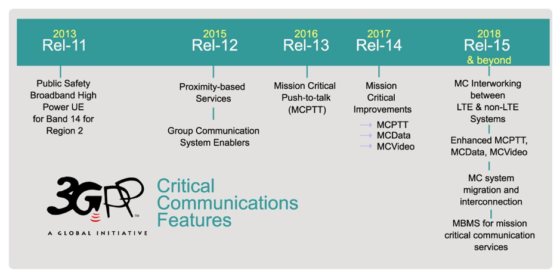
Comments
Post a Comment